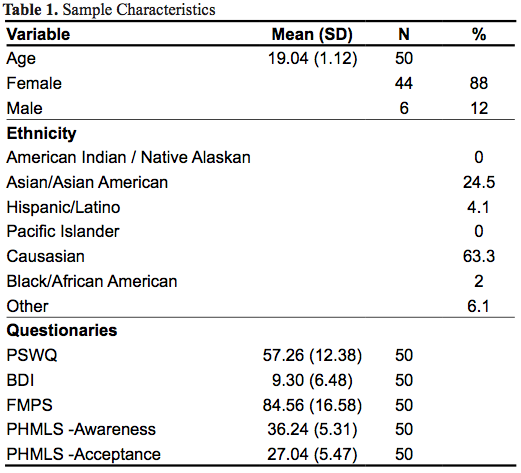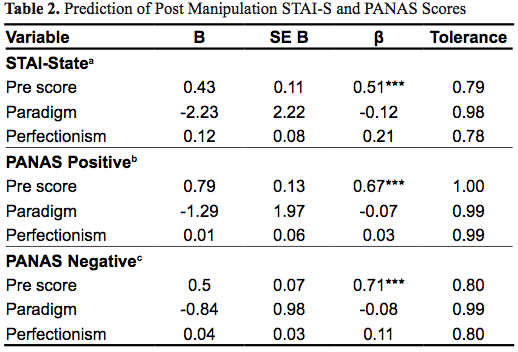Undergraduate psychology students completed questionnaires regarding mood, anxiety, worry and attention, listened to a pre-recorded dialogue that explained either mindful meditation or present-moment joy training, and completed questionnaires again.
In the Present Moment Joy condition, diaphragmatic breathing was taught and participants practiced the technique for ten minutes. The participants were then taught how to focus on the positive aspects of the present moment including intrinsic motivation and pleasant sensory experiences (the fresh smell, softness, etc) while folding towels for an additional five minutes.
In the Mindfulness Meditation group, participants were educated about mindfulness and were led through a twenty-minute Awareness of Breath exercise, which is a form of mindfulness meditation. During this breathing exercise, participants were instructed not to judge their experience or thoughts as positive or negative.
Frost Multidimensional Perfectionism Scale (FMPS): The FMPS is a 35-item self-report measure that provides a multidimensional assessment of perfectionism and yields a total perfectionism score and scores for six subscalesConcern over Mistakes (CM), Doubts About Actions (DA), Personal Standards (PS), Parental Expectations (PE), Parental Criticism (PC), and Organization (O). The Total Perfectionism Score is the sum of the subscales except O.
The CM scale reflects the self-critical and selfevaluative domains of perfectionism; the DA score reflects the uncertainty in the correctness of one’s decisions and actions; the PS score reflects an individual’s desire to set high standards of performance for oneself; the PE and PC scores reflect parent’s influences on an individual’s perfectionism, PE scores reflect expectations that parents have and PC scores reflect the amount of parental criticism; the O score measures an individual’s tendencies to be organized and orderly (Purdon, Antony & Swinson, 1999).
The FMPS asks each participant to rate each question from 1strongly disagree to 5-strongly agree. Scores range from 35 to 175, with higher scores indicating higher levels of perfectionism.
Philadelphia Mindfulness Scale (PHLMS): The PHLMS is a 20-item self-report measure that assesses mindfulness on two subscales, Acceptance and Awareness. The PHLMS asks participants to rate each question from 1Never to 5Very Often. Scores for the Awareness subscale range from 10 to 50, with higher scores indicating higher levels of awareness. Scores for the Acceptance subscale are reverse scored and summed, the range is from 10 to 50, with higher scores indicating higher levels of acceptance (Cardaciotto et al., 2008).
Beck Depression Inventory (BDI): The BDI is a 21item self-report questionnaire that measures the severity of depression in participants (Beck, Steer & Garbin, 1988). The BDI asks participants to rate each question on a 4 point scale ranging from 0 to 3. Scores range from 0 to 64 with higher scores indicating higher levels of depressive symptoms.
Penn State Worry Questionnaire (PSWQ): The PSWQ is a 16-item self-report questionnaire that measures the level of anxiety, or worry, in participants (Brown, Antony & Barlow, 1992). The PSWQ asks participants to rate each question from 1not at all typical to 5-very typical. Scores range from 16 to 80, with higher scores indicating greater worry.
Positive and Negative Affect Scale (PANAS): The PANAS is a 20-item self-report assessment that measures state positive affect and negative affect. This measure was given before and after the experimental task (Watson, Clark & Tellegen, 1988). The PANAS asks participants to rate questions from 1very slightly or not at all to 5extremely. Scores for both positive and negative affect range from 10 to 50, with higher scores indicating more positive and more negative aspect, respectively.
State Trait Anxiety Inventory for Adults (STAI-S): The STAI-S is a 20-item self-report assessment that has separate assesses current state anxiety in adults. This measure was given before and after the experimental task (Spielberger & Vagg, 1984). The STAI-S asks participants to rate their anxiety of a given situation ranging from 1-almost never to 4-almost always. Scores range from 20 to 80 with higher scores indicating greater anxiety.
The sample characteristics of the population are displayed in Table 1. No significant correlations were found between perfectionism and either of Awareness or Acceptance subscales of mindfulness. A main effect of time (pre-post) was found on the STAI-S F(1,46) = 42.07, p <.001, and on the PANAS in Negative affect F(1,48) = 33.43 p < .001, with both decreasing. No significant difference was found on the PANAS in Positive affect (p > .05). (See figures 1 and 2). A series of hierarchical simultaneous regressions were conducted with perfectionism predicting post manipulation STAI-S and PANAS scores. To control for pre-manipulation STAI-S and PANAS scores, premanipulation scores for the dependent variable were entered in Step 1 and paradigm (Joy or Meditation) was entered in Step 2. In Step 3, perfectionism total scores were simultaneously entered into the equation in order to examine the variance attributable to this variable (above and beyond those entered in Steps 1 and 2) (Table 2).

 Continued on Next Page »
Continued on Next Page »
Antony, M.M, Purdon, C.L., Huta, V. & Swinson, R.P. (1998). Dimensions of perfectionism across the anxiety disorders. Behaviour Research and Therapy, 36, 1143 – 1154.
Beck, A.T., Steer, R.A. & Garbin, M.G. (1988). Psychometric properties of the Beck Depression Inventory: Twentyfive years of evaluation. Clinical Psychology Review, 8(1), 77 – 100.
Besser, A., Flett, G.L. & Hewitt, P.L. (2010). Perfectionistic self-presentation and trait perfectionism in social problemsolving ability and depressive symptoms. Journal of Applied Social Psychology, 40(8), 2121 – 2154.
Bishop, S. R. (2002). What do we really know about mindfulness-based stress reduction? Psychosomatic Medicine, 64, 71-84.
Blankstein, K.R. & Lumley, C. H. (2008). Multidimensional perfectionism and ruminative brooding in current dysphoria, anxiety, worry, and anger. J Rat-Emo Cognitive-Behav Ther, 26, 168 – 193.
Block-Lerner, J., Salters-Pedneault, K. & Tull, M.T. (2005). Assessing Mindfulness and experiential acceptance: Attempts to capture inherently elusive phenomena. In S.M. Orsillo & L. Roemer (Eds), Acceptance and Mindfulness-Based Approaches to Anxiety (pp. 71 – 99). Springer US.
Borkovec, T.D. (2002). Life in the future versus life in the present. Clinical Psychology: Science and Practice, 9(1), 76 – 80.
Brown, T.A., Antony, M.M. & Barlow, D.H. (1992). Psychometric properties of the Penn state worry questionnaire in a clinical anxiety disorders sample. Behaviour Research and Therapy, 30(1), 33 – 37.
Buhlmann, U., Etcoff, N.L., Wilhelm, S. (2008). Facial attractiveness ratings and perfectionism in body dysmorphic disorder and obsessive-compulsive disorder. Journal of Anxiety Disorders. 22, 540 – 547.
Cardaciotto, L., Herbert, J.D., Forman, E.M., et al. (2008). The assessment of present-moment awareness and acceptance: The Philadelphia Mindfulness Scale. Assessment, 15(2), 204 – 223.
Carmody, J. & Baer, R.A. (2008). Relationships between mindfulness practice and levels of mindfulness, medical and psychological symptoms and well-being in the mindfulnessbased stress reduction program. J Behav Med, 31, 23 – 33.
Chang, E.C., Zumberg, K. M., Sanna, L.J. et al. (2007). Relationship between perfectionism and domains of worry in a college student population: considering the role of BIS/BAS motives. Personality and Individual Differences, 43, 925 – 936.
Cox, B.J. & Enns, M.W. (2003). Relative stability of dimensions of perfectionism in depression. Canadian Journal of Behavioral Science, 35(2), 124 – 132.
Davidson, R.J., Kabat-Zinn, J., Schumacher, J., et al (2003). Alterations in brain and immune function produced by mindfulness meditation. Psychomatic Medicine, 65, 564 – 570.
Fergus, T.A. & Wu, K.D. (2010). Is worry a thought control strategy relevant to obsessive-compulsive disorder? Journal of Anxiety Disorders, 24, 269 – 274.
Flett, G.L., Madorsky, D., Hewitt, P.L., Heisel, M.J. (2002). Perfectionism cognitions, rumination, and psychological distress. Journal of Rational-Emotive & Cognitive-Behavior Therapy, 20(1), 33 – 47.
Flett, G.L., Besser, A., Davis, R.A., & Hewitt, P.L. (2003). Dimensions of perfectionism, unconditional self-acceptance, and depression. Journal of Rational-Emotive Cognitive-Behavior Therapy, 21(2), 119 – 137.
Frost, R.O., Marten, P., Lahart, C., & Rosenblate, R. (1990). The dimensions of perfectionism. Cognitive Therapy and Research, 14(5), 449 468.
Frost, R.O., Heimberg, R.G., Holt, C.S, et al. (1993). A comparison of two measures of perfectionoism. Person. Individ. Diff., 14 (1), 119 – 126.
Frost, R.O. Shows, D.L. (1993). The nature and measurement of compulsive indecisiveness. Behave. Res. Ther., 31(7), 683 – 692.
Frost, R.O. & Steketee, G. (1997). Perfectionism in obsessive-compulsive disorder patients. Behav. Res. Ther. 35(4), 291 – 296.
Greeson, J.M. (2008). Mindfulness research. Complementary Health Practice Review, 14(1), 10 – 18.
Jain, S., Shapiro, S.L., Swanick, S., et al. (2007). A randomized control of mindfulness meditation versus relaxation training: Effects on distress, positive states of mind, rumination and distraction. Ann Behav Med, 33(1), 11 – 21.
Jha, A.P., Krompinger, J. & Baime, M.J. (2007). Mindfulness training modifies subsystems of attention. Cognitive, Affective & Behavioral Neurosciences, 7(2), 109 – 119.
Juster, H.R, Heimberg, R. G., Frost, R.O, et al. (1996). Social phobia and perfectionism. Person. Individ. Diff. 21(3), 403 – 410.
Kabat-Zinn, J. (1994). Wherever you go, there you are: Mindfulness meditation in everyday life. New York, NY.
Lundh, L.G. (2004). Perfectionism and acceptance. Journal of Rational-Emotive Cognitive-Behavior Therapy, 22(4), 255 – 269.
Lundh, L.G. & Ost, L.G. (1996). Recognition bias for critical faces in social phobics. Behav. Res. Ther. 34(10), 787 – 794.
Manzaneque, J.M., Vera, F.M., Ramos, N.S, et al. (2011). Psychobiological modulation in anxious and depressed patients after a mindfulness meditation programme: a pilot study. Stress and Health, 27, 216 – 222.
Perolini, C.M. (2012). Mindfulness and perfectionism as predictors of physical and psychological well-being in college students. ETD Collection for Fordham University.
Purdon, C., M.M. & Swinson, R.P. (1999). Psychometric properties of the Frost Multidimensional Perfectionism Scale in a clinical anxiety disorders sample. Journal of Clinical Psychology, 55(10), 1271 – 1286.
Ramel, W., Goldin, P.R., Carmona, P.E., & McQuaid, J.R. (2004). The effects of mindfulness meditation on cognitive processes and affect in patients with past depression. Cognitive Therapy and Research, 28(4), 433 – 455.
Rheaume, J., Freeston, M.H., Dugas, M.J., et al. (1995). Perfectionism, responsibility and obsessive-compulsive symptoms. Behav Res. Ther., 33(7), 785 – 794.
Saboonchi, F., Lundh, L.G. & Ost L.G. (1999). Perfectionism and self-consciousness in social phobia and panic disorder with agoraphobia. Behavior Research and Therapy. 37, 799 – 808.
Santanello, A.W. & Garder, F.L. (2006). The role of experiential avoidance in the relationship between maladaptive perfectionism and worry. Coginitive Therapy and Research, 30(3): 319 – 332.
Spielberger, C.D. & Vagg, P.R. (1984). Psychometric properties of the STAI: A reply to Ramanaiah, Franzen, and Schill. Journal of Personality Assessment, 48(1), 95 – 97.
Stober, J. & Joormann, J. (2001). Worry, procrastination, and perfectionism: differentiation amount of worry, pathological worry, anxiety and depression. Cognitive Therapy and Research. 25(1), 1 – 14.
Tang, Y.Y., Ma, Y., Wang, J., et al. (2007). Short-term mediation training improves attention and self-regulation. PNAS, 104(3), 17152 – 17156.
Watson, D., Clark, L.A. & Tellegen, A. (1988). Development and validation of brief measures of positive and negative affect: The PANAS Scales. Journal of Personality and Social Psychology, 54(6), 1063 – 1070.






















